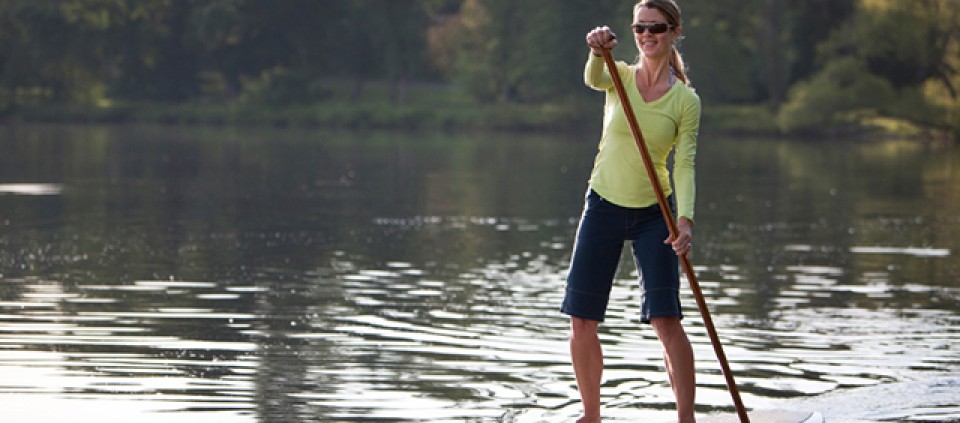Yoga Making Waves: Stand Up Paddleboard Yoga

Imagine being outdoors, stretching into Tree pose on a lovely summer day. Rooting down through your right leg, you lift and press your left foot against your inner thigh. Feeling secure, you slowly raise your arms above your head. As you gaze at the real trees in the distance, you become aware of a slight unsteadiness in your balance. Suddenly, you’re wobbling and…splash! You’re in the water.
Welcome to stand up paddleboard yoga, an offshoot of the water sport that originated in Hawaii’s surfing community in the 1960s. As stand up paddleboarding (SUP) spread to other warm-weather places, it became popular as a fitness and recreation activity. Not long after, SUP yoga was born, creating a new, floating arena for an ancient practice.
“It was a chance for people to combine the things that they loved—yoga, water, SUP, and nature,” says Ryan Burch, co-owner with his wife, Juliet, of SUPfari Adventures in Brewster, Massachusetts. “They realized that their paddleboard could easily be used as a floating yoga mat, and it didn’t take long for that to catch on.”
Today there are SUP yoga classes and teacher certification programs around the country, and Ryan and Juliet bring the practice to Kripalu this summer with Float Your Yoga: A Stand Up Paddleboard Weekend, July 19–21, where they’ll be taking their students out of the building and onto Lake Mahkeenac.
The Burches began offering Float Your Yoga classes on Cape Cod in the summer of 2011, turning SUP enthusiasts into yogis and vice versa. The class features yoga poses and practices modified for the paddleboard (which resembles an oversized surfboard) and the unpredictable aquatic environment. For anyone with balance issues, the concept can be daunting, if not improbable.
“People’s initial reaction is, ‘You’re doing what? How do you do that?’” Ryan says. “But once we get people out there and comfortable on the boards, there’s a lot of playfulness and fun. Students tell us that they’re getting a really good workout, too, and now the local yoga studios want to get involved.”
Juliet, a dancer, massage therapist, and yoga teacher from South Africa, takes advantage of the many beaches on Cape Cod to offer waterside classes. She says that her beach yoga students were keen to float their practice once they learned that it could be done. “In addition to the stretching and movement, there’s a lot of peace and serenity that comes from the floating action and the sounds of practicing on water,” she says. “It’s all really wonderful stimulation.”
Float Your Yoga classes at SUPfari Adventures take place during morning and evening hours in calm coves that are protected from the wind. The paddleboards are anchored in a way that keeps them in one area, and the class begins with water safety instruction and lessons in such crucial skills as paddling and getting on and off the board. Once these basics are covered and people learn to sit, kneel, and stand on their boards, they are led through classic postures such as Warrior, Mountain, Dolphin, Plank, Boat, Bridge, and Downward Dog. Seated twists can be done straddling the board, and balancing poses take on a whole new dimension atop the water.
“We’ve done Tree pose and that’s been fun, even when people fall off the board. When they do, they simply laugh and get back on,” says Juliet. “Most often, everyone’s actually really well balanced because we do focus, take it slowly, and tune in to what we’re doing. It definitely helps you master concentration.”
Ryan says that the most challenging aspect of SUP yoga for beginners is getting from a prone or knee-down position to a standing one. Balancing weight distribution is key to success in this transition. “We always tell students that, if you go ‘Whoa!’ you should get low, meaning that you should lower your center of gravity when you feel off balance to increase your stability,” says Ryan. “You can also use your paddle as a brace, and the paddle becomes a kind of third arm or leg to help us get from kneeling to standing.”
Once students get their sea legs on the paddleboard, SUP yoga offers them a significant core workout. “It really changes the dynamics of yoga,” says Ryan. “In a typical classroom, you concentrate on your breath and the poses. Here, you are also concentrating on how much pressure you’re putting on one side versus the other, working your inner thighs and engaging smaller, stabilizing muscles that you wouldn’t work when practicing on a stable surface.”
After all that effort to balance, move from pose to pose, and stay out of the water, relaxation is particularly welcome. Juliet says that Savasana is quite a different experience on a floating mat. “It’s often our favorite part of the class, as we lie on the board and just let our hands trail in the water, gazing up at the sky and taking it all in.”
© Kripalu Center for Yoga & Health. All rights reserved. To request permission to reprint, please e-mail editor@kripalu.org.